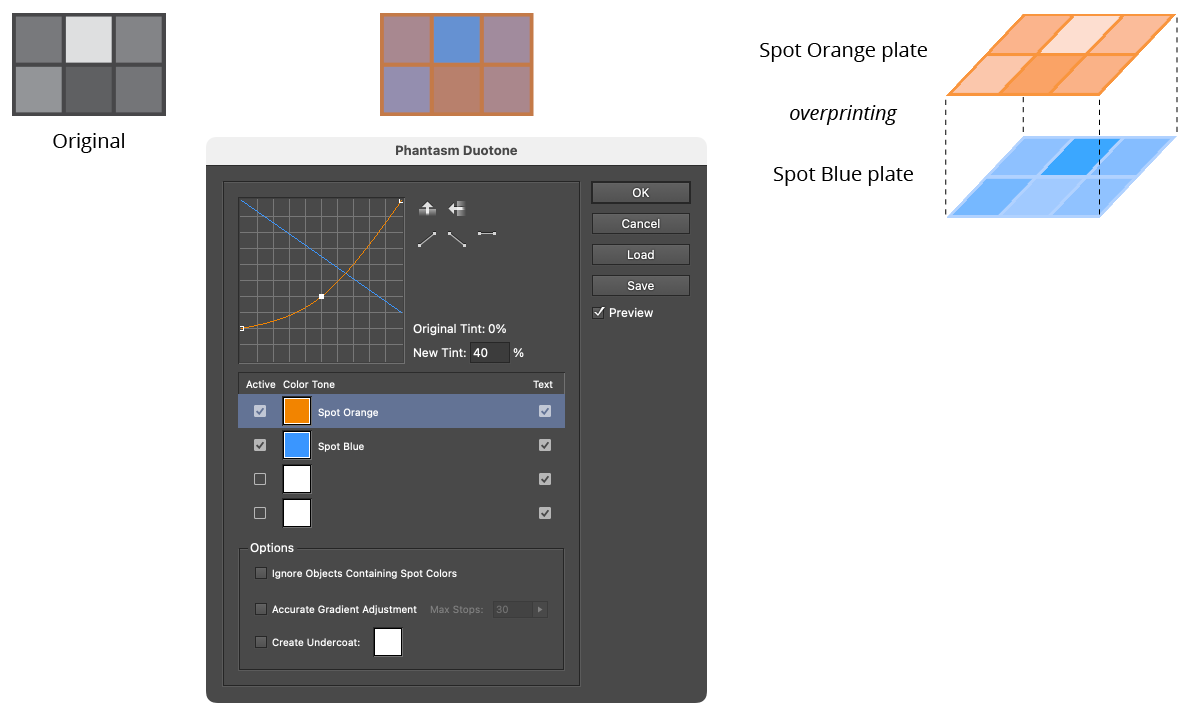 Duotone
Duotone
Phantasm Duotone is a live effect/filter that creates Duotones (or Monotones, Tritones, or Quadtones) from artwork. It is strongly advised that you enable Overprint Preview (in the View menu) before applying the live effect/filter, as it relies on the overprinting of spot colors where applicable.
As a live effect, it is accessible through the main menu, under Effect > Phantasm > Duotone. It can also be applied directly from the Appearance panel using the “Add New Effect” button at the bottom of the panel, or through the Phantasm panel (see Phantasm: Panel).
After applying the live effect using the menu item (or when clicking on the existing effect in the Appearance panel to edit it), the parameters dialog will appear:

Phantasm Duotone Dialog
1. Color Tone Graph
Shows the relationships between the original tints (shown on the horizontal axis) and the new tints (on the vertical axis) for each color. The graph for the selected color will show nodes, which can be moved (vertically only, as per Photoshop) by dragging them. New nodes can be added by clicking along the curve, but only at horizontal positions where the original tint is a multiple of 10%, plus 5% and 95%. Except for the end nodes, a node can be deleted by dragging it off the graph area.
2. Graph Action Buttons
These five buttons that act to change the selected graph. Flip Vertical and Flip Horizontal flip the graph accordingly; the three lower buttons reset the graph to default linear (0% to 100%), inverse linear (100% to 0%), and full-strength (all 100%), after which it may be edited further as usual.
3. New Tint Input
When a node on a graph is selected, its new tint value (vertical position on the graph) will be displayed here and may be edited numerically.
4. Color Tone List
Shows up to four color tones to use in the effect. Although the color tones are typically spot colors, they may also be process colors (in which case the Multiply transparency effect is used to combine the different tones). The selected color tone in the list is highlighted in a gray-blue; only the selected color tone’s graph is active above and may be edited.
Active Checkbox: Specifies whether a given color tone is part of the effect. If only a single color is active, the result will be a Monotone; if two are active, a Duotone, and so on.
Color Chip: May be clicked to select a new color through the color picker dialog. However, this dialog does not provide for creating new spot colors so these should be created in the normal way on the Swatches panel before applying the Duotone filter or effect. If a new process color is created, it may be renamed by
doubleclickingon the color name in the Color Tone List.Text Checkbox: Specifies whether any editable text present in the selection is rendered in that tone. This can allow users to ensure registration problems are avoided with text by limiting the number of tones in which the text is rendered. Care should be taken when using this option, as various scenarios could mean the text vanishes beneath another color tone.

Phantasm Duotone Example
5. Ignore Objects Containing Spot Colors
When enabled, any objects or groups in the selection which contain objects defined with spot colors will not be rendered as a duotone.
6. Accurate Gradient Adjustment
Acts as per other Phantasm effects (See Phantasm: Common Options (Advanced)).
7. Create Undercoat
When enabled, creates a solid, opaque, “undercoat” color for blocking out any underlying artwork which might normally show through due to overprints being added. White is most commonly used as the undercoat color, but it can be changed by clicking on the color chip to bring up the standard color picker dialog.
